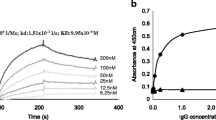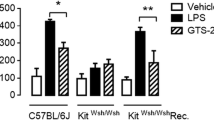Abstract
Introduction
Muscarinic acetylcholine receptors (mAChR) belong to the G-protein-coupled receptor family and are extensively expressed in most cells in mammals. We had reported the expression of mAChR in murine and human breast tumors.
Methods
The presence of antibodies in the sera of patients with different tumors directed against self-proteins has been recently described. In this work, we investigated the presence of autoantibodies against mAChR in the sera of breast cancer patients in stage I (T1N0Mx-IgG). IgG purification was performed by affinity chromatography in protein G-agarose. We also studied the ability of these antibodies to modulate the proliferation of MCF-7 breast tumor cells by the MTS colorimetric assay. The ability of T1N0Mx-IgG to stimulate muscarinic signaling pathway via nitric oxide synthase was tested by Griess reaction.
Results
We demonstrated M3 and M4 receptors expression in MCF-7 cells. T1N0Mx-IgG promotes cell proliferation, mimicking the action of the muscarinic agonist carbachol. This effect was preferentially due to M3 receptor activation in tumor cells via phospholipase C-induced nitric oxide liberation by calcium-dependent nitric oxide synthases. IgG from control patients was unable to produce this effect.
Discussion
IgG from patients with breast cancer in early stages could be promoting tumor progression by muscarinic activation, and its presence could be determining the prognosis of this illness.





Similar content being viewed by others
References
Jakóbisiak M, Lasek W, Golab J. Natural mechanisms protecting against cancer. Immunol Lett. 2003;90:103–22.
Boon T, Cerottini JC, Van den Eynde B, van der Bruggen P, Van Pel A. Tumor antigens recognized by T lymphocytes. Annu Rev Immunol. 1994;12:337–66.
Witkin SS. Heat shock protein expression and immunity: relevance to gynecologic oncology. Eur J Gynaecol Oncol. 2001;22:249–56.
Antoine JC, Absi L, Honnorat J, Boulesteix JM, de Brouker T, Vial C, et al. Antiamphiphysin antibodies are associated with various paraneoplastic syndromes and tumors. Arch Neurol. 1999;56:151–2.
Fernandez Madrid F, Karvonen RL, Ensley J, Kraut M, Granda JL, Alansari H, et al. Spectra of antinuclear antibodies in patients with squamous cell carcinoma of the lung and of the head and neck. Cancer Detect Prev. 2005;29:59–65.
Hansen MH, Nielsen H, Ditzel HJ. The tumor infiltrating B cell response in medullary breast cancer is oligoclonal and directed against the autoantigen actin exposed on the surface of apoptotic cancer cells. Proc Natl Acad Sci USA. 2001;98:12659–64.
Eglen RM. Muscarinic receptor subtype: pharmacology and physiology. Prog Med Chem. 2005;43:105–36.
Peraza-Cruces K, Gutiérrez-Guédez L, Castañeda Perozo D, Lankford CR, Rodríguez-Bonfante C, Bonfante-Cabarcas R. Trypanosoma cruzi infection induces up-regulation of cardiac muscarinic acetylcholine receptors in vivo and in vitro. Braz J Med Biol Res. 2008;41:796–803.
Koch HJ, Haas S, Jürgens T. On the physiological relevance of muscarinic acetylcholine receptors in Alzheimer’s disease. Curr Med Chem. 2005;12:2915–21.
Sogn JA. Tumor immunology: the glass is half full. Immunity. 1998;9:757–63.
Abken H, Hombach A, Heuser C, Kronfeld K, Seliger B. Tuning tumor-specific T-cell activation: a matter of costimulation? Trends Immunol. 2002;23:240–5.
Paleari L, Grozzio A, Cesario A, Russo P. The cholinergic system in cancer. Semin Cancer Biol. 2008;18:211–7.
Español AJ, Sales ME. Different muscarinic receptors are involved in the proliferation of murine mammary adenocarcinoma cell lines. Int J Mol Med. 2004;13:311–9.
Fiszman G, Cattaneo V, de la Torre E, Español A, Colombo LL, Sacerdote de Lustig E, et al. Muscarinic receptors autoantibodies purified from mammary adenocarcinoma bearing mice sera stimulate tumor progression. Int Immunopharmac. 2006;6:1323–30.
Chen TR. In situ detection of micoplasma contamination in cell cultures by fluorescent Hoechst 33258 stain. Exp Cell Res. 1977;104:255–62.
Bradford MM. A rapid and sensitive method for the quantification of microgram quantities of protein utilizing the principle of protein-dye binding. Anal Biochem. 1976;72:248–54.
Granger DL, Hibbs JB, Perfect JR, Durack DT. Metabolic fate of L-arginine in relation to microbiostatic capability of murine macrophages. J Clin Invest. 1990;85:264–73.
Español AJ, Eiján AM, Mazzoni EO, Davel L, Jasnis MA, Lustig ES, et al. Nitric oxide synthase, arginase and cyclooxygenase are involved in muscarinic receptors activation in different murine mammary adenocarcinoma cell lines. Int J Mol Med. 2002;9:651–7.
Wessler I, Roth E, Deutsch C, Brockerhoff P, Bittinger F, Kirkpatrick CJ, et al. Release of non-neuronal acetylcholine from isolated human placenta is mediated by organic cation transporters. Br J Pharmacol. 2001;134:951–6.
Shah N, Khurana S, Cheng K, Raufman JP. Muscarinic receptors and ligands in cancer. Am J Physiol Cell Physiol. 2009;296:221–32.
Fiszman GL, Sales ME. Antibodies against muscarinic receptors in breast cancer: agonizing tumor growth. Curr Immunol Rev. 2008;4:1–7.
Hernandez CC, Nascimento JH, Chaves EA, Costa PC, Masuda MO, Kurtenbach E, et al. Autoantibodies enhance agonist action and binding to cardiac muscarinic receptors in chronic Chagas’ disease. J Recept Signal Transduct Res. 2008;28:375–401.
Wu Y, Li MT, Zhao Y, Feng S, Su L, Dong Y. The clinical significance of autoantibodies against acetylcholine muscarinic 3 receptor in primary Sjögren’s syndrome. Zhonghua Nei Ke Za Zhi. 2008;47:563–5.
Sales ME, Español AJ, Sterin-Borda L, Borda E, de Bracco MM. Protein kinase C regulates NO-cGMP pathway in muscarinic receptor activation by HIV + -IgA. Int J Mol Med. 1999;3:633–7.
Fernández Madrid F. Autoantibodies in breast cancer sera: candidate biomarkers and reporters of tumorigenesis. Cancer Lett. 2005;230:187–98.
Schulze W, Kunze R, Wallukat G. Pathophysiological role of autoantibodies against G-protein-coupled receptors in the cardiovascular system. Exp Clin Cardiol. 2005;10:170–2.
Issafras H, Angers S, Bulenger S, Blanpain C, Parmentier M, Labbé-Jullié C, et al. Constitutive agonist-independent CCR5 oligomerization and antibody-mediated clustering occurring at physiological levels of receptors. J Biol Chem. 2002;277:34666–73.
Williams CL. Muscarinic signaling in carcinoma cells. Life Sci. 2003;72:2173–82.
Song P, Sekhon HS, Fu XW, Maier M, Jia Y, Duan J, et al. Activated cholinergic signaling provides a target in squamous cell lung carcinoma. Cancer Res. 2008;68:4693–700.
Raufman JP, Samimi R, Shah N, Khurana S, Shant J, Drachenberg C, et al. Genetic ablation of M3 muscarinic receptors attenuates murine colon epithelial cell proliferation and neoplasia. Cancer Res. 2008;68:3573–8.
Rimmaudo LE, de la Torre E, Sacerdote de Lustig E, Sales ME. Muscarinic receptors are involved in LMM3 tumor cell proliferation and angiogenesis. Biochim Biophys Res Comun. 2005;334:1360–5.
O’Shaughnessy MJ, Chen ZM, Gramaglia I, Taylor PA, Panoskaltsis-Mortari A, Vogtenhuber C, et al. Elevation of intracellular cyclic AMP in alloreactive CD4(+) T cells induces alloantigen-specific tolerance that can prevent GVHD lethality in vivo. Biol Blood Marrow Transplant. 2007;13:530–42.
Chiaradonna F, Balestrieri C, Gaglio D, Vanoni M. Ras and PKA pathways in cancer: new insight from transcriptional analysis. Front Biosci. 2008;13:5257–78.
Nathanson NM. A multiplicity of muscarinic mechanisms: enough signaling pathways to take your breath away. PNAS. 2000;97:6245–7.
Elkon K, Casali P. Nature and functions of autoantibodies. Nat Clin Pract Rheumatol. 2008;4:491–8.
Lancaster JR, Xie K. Tumors face NO problems? Cancer Res. 2006;66:6459–62.
Reina S, Sterin-Borda L, Orman B, Borda E. Human mAChR antibodies from Sjögren syndrome sera increase cerebral nitric oxide synthase activity and nitric oxide synthase mRNA level. Clin Immunol. 2004;113:193–202.
Waid DK, Chell M, El-Fakahany EE. M(2) and M(4) muscarinic receptor subtypes couple to activation of endothelial nitric oxide synthase. Pharmacology. 2000;61:37–42.
Acknowledgments
The authors want to thank Mrs. María Ester Castro for her excellent technical assistance. This work was supported by grants from University of Buenos Aires (UBACYT MO064) and from the National Agency for Scientific and Technology Promotion (ANPCyT PICT 2006-485). Drs. Alejandro J. Español and María Elena Sales are established investigators in the National Research Council of Argentina (CONICET). Dr. Eulalia de la Torre is a fellow from CONICET.
Author information
Authors and Affiliations
Corresponding author
Rights and permissions
About this article
Cite this article
Negroni, M.P., Fiszman, G.L., Azar, M.E. et al. Immunoglobulin G from Breast Cancer Patients in Stage I Stimulates Muscarinic Acetylcholine Receptors in MCF7 Cells and Induces Proliferation. Participation of Nitric Oxide Synthase-Derived Nitric Oxide. J Clin Immunol 30, 474–484 (2010). https://doi.org/10.1007/s10875-010-9370-0
Received:
Accepted:
Published:
Issue Date:
DOI: https://doi.org/10.1007/s10875-010-9370-0




